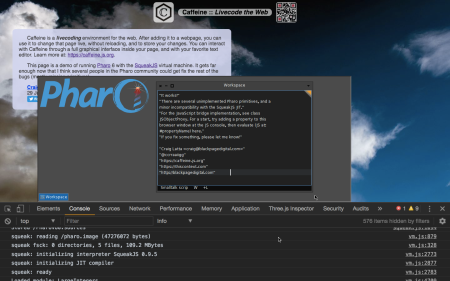
Some of those methods were there for a very long time!
I have adapted the minimization technique from the Naiad module system to Caffeine, my integration of OpenSmalltalk with the Web and Node platforms. Now, from a client Squeak, Pharo, or Cuis system in a web browser, I can make an EditHistory connection to a history server Smalltalk system, remove via garbage collection every method not run since the client was started, and imprint needed methods from the server as the client continues to run.
This is a garbage collection technique that I had previously called “Dissolve”, but I think the details are easier to explain with a different metaphor: “shaking” loose and removing everything which isn’t attached to the system through usage. This is a form of dynamic dead code elimination. The technique has two phases: “fusing” methods that must not be removed, and “shaking” loose all the others, removing them. This has a cascading effect, as the literals of removed methods without additional references are also removed, and further objects without references are removed as well.
After unfused methods and their associated objects are removed, the subsystems that provided them are effectively unloaded. For the system to use that functionality again, the methods must be reloaded. This is possible using the Naiad module system. By connecting a client system to a history server before shaking, the client can reload missing methods from the server as they are needed. For example, if the Morphic UI subsystem is shaken away, and the user then attempts to use the UI, the parts of Morphic needed by the user’s interactions are reloaded as needed.
This technology is useful for delineating subsystems that were created without regard to modularity, and creating deployable modules for them. It’s also useful for creating minimal systems suited to a specific purpose. You can fuse all the methods run by the unit tests for an app, and shake away all the others, while retaining the ability to debug and extend the system.
how it works
Whether a method is fused or not is part of the state of the virtual machine running the system, and is reset when the virtual machine starts. On system resumption, no method is fused. Each method can be told to fuse itself manually, through a primitive interface. Otherwise, methods are fused by the virtual machine as they are run. A class called Shaker knows which methods in a typical system are essential for operation. A Shaker instance can ensure those methods are fused, then shake the system.
Shaking itself invokes a variant of the normal OpenSmalltalk garbage collector. It replaces each unfused method with a special method which, when run, knows how to install the original method from a connected history server. In effect, all unfused methods are replaced by a single method.
Reinstallation of a method uses Naiad behavior history metadata, obtained by remote messaging with a history server, to reconstruct the method and put it in the proper method dictionary. The process creates any necessary prerequisites, such as classes and shared pools. No compiler is needed, because methods are constructed from previously-generated instructions; source code is merely an optional annotation.
the benefits of livecoding all the way down
I developed the virtual machine support for this feature with Bert Freudenberg‘s SqueakJS virtual machine, making heavy use of the JavaScript debugger in a web browser. I was struck by how much faster this sort of work is with a completely livecoded environment, rather than the C-based environment in which we usually develop the virtual machine. It’s similar to the power of Squeak’s virtual machine simulator. The tools, living in JavaScript, aren’t as powerful as Smalltalk-based ones, but they operate on the final Squeak virtual machine, rather than a simulation that runs much more slowly. Rebuilding the virtual machine amounts to reloading the web page in which it runs, and takes a few seconds, rather than the ordeal of a C-based build.
Much of the work here involved trial and error. How does Shaker know which methods are essential for system operation? I found out directly, by seeing where the system broke after being shaken. One can deduce some of the answer; for example, it’s obvious that the methods used by method contexts of current processes should be fused. Most of the essential methods yet to run, however, are not obvious. It was only because I had an interactive virtual machine development environment that it was feasible to restart the system and modify the virtual machine as many times as I needed (many, many times!), in a reasonable timeframe. Being able to tweak the virtual machine in real time from Smalltalk was also indispensable for debugging and feature development.
I want to thank Bert again for his work on SqueakJS. Also, many thanks to Dan Ingalls and the rest of the Lively team for creating the environment in which SqueakJS was originally built.
release schedule
I’m preparing Shaker for the next seasonal release of Caffeine, on the first 2019 solstice, 21 June 2019. I’ll make the virtual machine changes available for all OpenSmalltalk host platforms, in addition to the Web and Node platforms that Caffeine uses via the SqueakJS virtual machine. There may be alpha and beta releases before then.
If this technology sounds interesting to you, please let me know. I’m interested in use cases for testing. Thanks!








 We’ve seen a couple of examples of frontend Caffeine development, using
We’ve seen a couple of examples of frontend Caffeine development, using 

 Since
Since  For the impatient…
For the impatient…